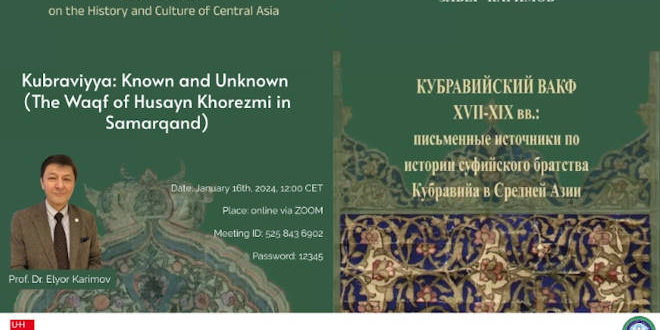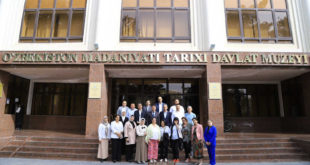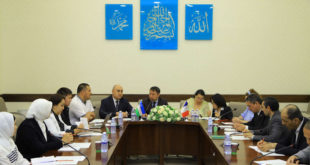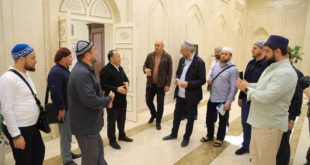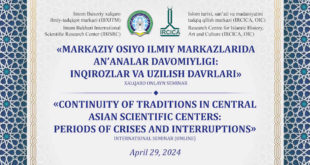-

Photo: © Karimov & Sinani
We are pleased to kindly invite you to the last lecture of this term’s lecture series on the history and culture of Central Asia, which is jointly organised by the Department of Islamic Studies at the Asien-Afrika-Institut (Universität Hamburg) and the İmam Bukhari International Scientific Research Center under the Cabinet of Ministers of the Republic of Uzbekistan. This time we will have the oppurtinty to hear from Prof. Dr. Elyor Karimov, Adjunct Professor at the Hofstra University (Hempstead, New York), who will give a lecture on the Kubraviyya sufi tariqa and the waqf of Husayn Khorezmi in Samarqand.
- Subject: Kubraviyya: Known and Unknown (The Waqf of Husayn Khorezmi in Samarqand)
- Lecturer: Prof. Dr. Elyor Karimov, Adjunct Professor at the Hofstra University (Hempstead, NY)
- Date: January 16th, 2024, at 12:00 CET
- Place: online via ZOOM.
Abstract:
The Kubraviyya Sufi tariqa, alongside with other Sufi brotherhoods as the Yasaviyya and Naqshbandiyya Orders, is one of the main autochthonous brotherhoods established in Central Asia. Nevertheless, the study on the social, political, and economic history of the Kubraviyya remains full of contradictions and gaps. As with all historical problems, the complexity of studying the Kubraviyya tradition is determined by an insufficient amount of historical written sources that would allow researchers to assess this Sufi brotherhood in a more nuanced historical perspective.
While the history of the founding of the Kubraviyya and its early development are not controversial, the study of more recent periods is, because of missing historical information. In a relatively short time, the Kubraviyya held a strong position in Central Asia.
Moreover, this tariqa can be credited as being a pioneer in the political, public, and economic domain. Who among Najm ad-Din Kubra’s disciples remained active and became either well-known theologists of a mystical way, or the authors of classical works on Sufism, or people who contributed to the solidifying and spreading of Islam in general?
One of his most famous disciples in Central Asia is Shaykh Kamal al-Din Husayn Khwarazmi. Only few facts are known concerning the life and activity of Shaykh Kamal al-Din Husayn Khwarazmi. These information were repeated all over in a multitude of studies: The role of Husayn Khwarazmi is being limited to a ‘brief revival of the former power and influence of Kubraviya’ (O.F.Akimushkin) and ‘Kubravi presence in the Turkic milieu on the frontiers of the Islamic world down to the early 15th century’ (D. DeWeese).
A whole new layer of information is provided by the Samarqand Waqf-nama of Husayn Khwarazmi that has escaped the attention of most of the researchers. This unique document was first described by R.G. Mukminova in 1965 and more recently, in 2008, the presenter published its full text. The Waqf-nama of Husayn Khwarazmi allows us to throw new light on the still unknown pages of the late history of Kubraviyya in Central Asia.
Photo: E. Karimov
Profile of the lecturer:
Elyor Karimov is an Adjunct Professor at Hofstra University since 2017, he obtained his Ph.D. in 1990 from the Uzbek Academy of Sciences. His doctoral dissertation focused on the social positions of clergy in 15th-century Maverannahr. Later, in 1998, he earned a Sc.D. with a thesis centered on Sufi tariqats in Central Asia between the 12th and 15th centuries.
Karimov’s scholarly interests primarily revolve around Islamic Central Asia in the context of the broader Mediaeval to Modern Middle East. His research spans diverse subjects, including the study of Mediaeval Persian and Chagatai manuscripts, exploration of pilgrimage centers like mausoleums and mosques, and investigation of Central Asian literary, artistic, and scholarly communities during colonial and Soviet periods.
He has authored and co-authored several books, including “Religion Made Official: a Comprehensive Collection of Documents from the State Archives of Soviet Uzbekistan, 1920s – 1960s” with David Abramson (2009) and “The Kubraviya Waqf (17th-19th Centuries): Written Sources on the Late History of the Kubravi Sufi Brotherhood in Central Asia” (2008).
In order to participate, please use the following Zoom data:
Meeting ID: 525 843 6902
Password: 12345
 Imom Buxoriy xalqaro ilmiy-tadqiqot markazi bukhari.uz
Imom Buxoriy xalqaro ilmiy-tadqiqot markazi bukhari.uz










